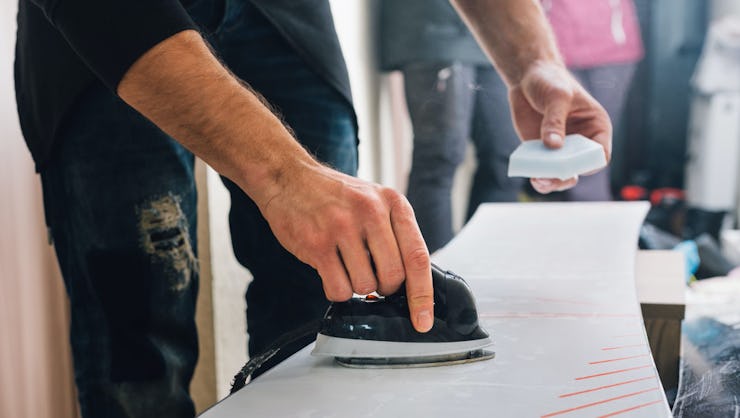The best snowboard wax
We only recommend products we love and that we think you will, too. We may receive a portion of sales from products purchased from this article, which was written by our Commerce team.

Snowboarding wax is important. I can tell you from personal experience that getting stuck on a long traverse is a great way to ruin a fresh powder day. When you’re shopping for the best snowboard wax, it’s helpful to understand why you need it in the first place and how it works. For help with this and other wax-related questions, I emailed Graham Lonetto, Alpine Director for Swix Sport USA.
Why do you need snowboard wax?
There are three main reasons to use snowboard wax:
- It makes you faster: Fresh wax allows you to glide more smoothly over the snow.
- It extends the life of your board: Waxing your board prevents your base from drying out, thus reducing wear and tear, according to Pirates Of Powder.
- It keeps you safer: As Lonetto explains, without wax, it’s easier for sticky snow to grab your board and launch you forward
According to Lonetto, wax essentially “helps move a layer of water” between your board and the snow. This reduces friction and lets your board glide more quickly and smoothly over the snow.
Types of snowboard wax
There are three main types of snowboard wax — warm weather, cold weather, and all-season. The difference between them, Lonetto explained, is the hardness. “Selecting the correct hardness helps the wax ‘roll over’ the snow crystal, creating and or moving water between the ski and the snow,” he said.
The type you should choose will depend on the weather conditions and your snowboarding style. Generally speaking, more advanced, high-performance riders will usually want temperature-specific waxes to more precisely match the conditions of the day. That said, these waxes are more of a hassle because you have to factor in weather and change waxes more frequently, which can be time-consuming.
For that reason, all-season wax is often a better choice for recreational snowboarders or weekend warriors who just want something simple and effective. It’s nearly as good and will work great in a wide variety of snow conditions.
When is snowboard wax most important?
It’s more important to have fresh wax on certain days than others. On cold days, for example, it’s fun to have fresh wax because it lets you race down the hill faster and glide over choppy snow more easily. However, it doesn’t really impact your safety. On warm days, by contrast, snowboard wax is more critical, especially if you’re someone who rides fast. “From a safety standpoint, warm sticky snow is probably the most important condition for selecting wax,” Lonetto explained. “… The warm, wet, grabby snow can be dangerous.”
With all of this in mind, I’ve put together a list of the best snowboard waxes that will last all the way to spring. Take a look to find the one that’s best for you.
1. The best all-temperature wax
The lowdown: Designed to keep you moving fast in virtually every type of weather condition, this is some of the best all temperature snowboard wax out there. The universal snowboard wax can be applied hot or cold, depending on your preference and how much time you have. It comes in a 0.75-pound block and boasts an impressive temperature range, from 6 to 52 degrees Fahrenheit, making it a fantastic overall option for the everyday rider.
Proof from fans: “Hertel is a fantastic all condition race wax. Used in the Pacific Northwest as temperatures change and on ice, slush, hard pack and grippy snow and performed fantastic. Great race performance at a reasonable price and without having to figure out which wax is right for the day, it works well across the board. Wax before you go and race for the weekend with confidence.”
2. The best cold-weather wax
The lowdown: When the temperatures start dropping into the teens and single digits, this biodegradable snowboard wax from Swix is a great choice. It works on especially frigid days in any air temperatures ranging from -4 degrees to 14 degrees Fahrenheit. Unlike the all-purpose wax, which can also be rubbed on cold, this hydrocarbon wax performs best when applied hot. As a bonus, it’s environmentally friendly, too.
Proof from fans: “I love using this wax. It's well priced for others on the market, and the performance is stellar.”
3. The best warm-weather wax
The lowdown: On slushy spring days when the snow tends to be sticky, you can’t beat this warm weather snowboard wax from ZÜMWax. The 100% hydrocarbon racing wax is compatible with air temperatures ranging from 25 to 50 degrees Fahrenheit — perfect for sunny, laidback March sessions. This one will also give you the best results when applied with a hot iron.
Proof from fans: “I have a wax I love for much of the skiing season but when it gets warm and slushy I felt like I was going to go head over heals at the bottom of the hill. This is great for warmer slushy snow, much faster and the snow isn't sticky anymore.”
4. The best wax kit
The lowdown: If you’re looking for a full-on snowboard wax kit, this all-inclusive choice from Dakine features everything you need. In addition to a small block of high-quality hydrocarbon wax, it comes with a quick-heating iron and a scraper. Not only that, but it also has a file, edging tool, small stone, and P-tex to sharpen your edges or fill chips in your base. It’s great if you’re heading out of town for the weekend, offering an easy-grab bag that’s always ready to go.
Proof from fans: “The scraper's and wax iron worked amazingly, and my ski's glided and edged beautifully. Makes me wonder how bad most ski shops are at tuning. [Definitely] worth doing it yourself.”